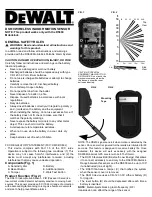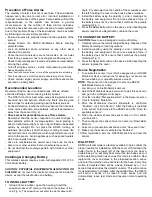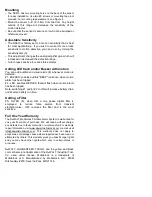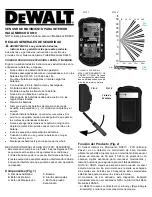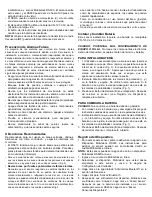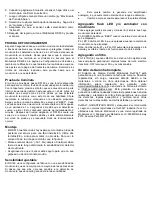
Prevention of False Alarms
The majority of alarms that occur are false. These situations
happen every day due to user error, incorrect installation or
improper maintenance of the system. False alarms will limit the
responsiveness to the system and become a general
inconvenience. As the number of false alarms increases,
authorities have become less apt to respond to alarm systems
due to this problem. Many of these situations can be avoided
by following some very simple practices.
•
Ensure all users are properly trained on the operation of the
system
.
• Always Disarm the DS600 Mobilelock before entering
protected area.
• Lock all protected doors, windows or any other asset
attached to a sensor.
• Check that motion detectors are not obstructed. Do not install
them facing a window or near a heating/air conditioning vent.
• Check that premises are cleared and assets secured before
Arming the system.
• Turn off all noise sources – radios, compressors, generators,
heavy equipment, etc.
• Know how to cancel an alarm or turn off the system before activating.
• Test the system on a monthly basis to ensure proper functioning
• Check cellular signal, power supply, and that sensors are
secured on a daily basis.
Recommended Locations
Recommended for use in enclosed areas, offices, climate
controlled storage, and monitoring interior spaces.
• The DS610 functions best when areas being protected are
bounded by solid barriers. Walls and floors provide good
back- drops for detecting moving heat (infrared) sources.
• For best detection, locate the motion sensor so that intruders
move across detection zone patterns, rather than toward or
away from the sensor (Fig. 2).
•
Check areas for potential sources of false alarms.
Remember that the sensor responds to quick changes in
heat patterns within its coverage pattern. Avoid placing in
direct or reflected sunlight, or near objects that can be heated
quickly by sunlight. Do not place the DS610 looking at
windows. Don’t place it near heating or cooling sources, like
heater ducts or air conditioners, which might direct hot or cold
air onto the sensor. Avoid appliances such as space heaters
which can rapidly heat up.
• Take into consideration the normal use of the area. Are there
bats, mice or other animals that could activate the sensor?
• Do not obstruct the coverage pattern with furniture or other
equipment.
Installing & Changing Battery
This wireless sensor requires a non-rechargeable CR-123 3.0
Volt Lithium battery.
CAUTION: POTENTIAL EQUIPMENT MALFUNCTION OR
FAILURE.
Do not touch the electronic components inside the
device, except the reset button and battery.
TO INSTALL BATTERY
angle. Pry downward on the handle of the screwdriver until
the latch holding the cover to the housing base releases.
2. Install the battery using the polarity (+ and -) markings on
the battery and equipment. Do not use excessive force. If
the battery does not fit, ensure that it matches the polarity
markings (Fig. 1).
3. Press the Reset Button (B) on the device. After resetting the
sensor (see Device Registration), replace the cover.
TO CHANGE THE BATTERY
CAUTION:
Never use a damaged or worn-out battery.
1. Carefully remove the old, discharged battery. Dispose of the
battery according to local regulations.
2. Install new battery using the polarity (+ and -) markings on
the battery and equipment. Do not use excessive force. If
the battery does not fit, ensure that it matches the polarity
markings (Fig. 1).
3. Press the Reset Button (B) on the device. After resetting the
sensor, replace the cover.
Device Registration
1. To activate this sensor, it must first be assigned to your DS600
Mobilelock Device. Instructions for assigning your sensor can
be found within your online Mobilelock account.
NOTE:
This sensor can be assigned to only one DS600
Mobilelock device at a time.
1. Log into your online Mobilelock account
2. Select the Mobilelock device you wish to pair this sensor to
and go to the Configure Units page.
3.
Click the link titled “Manage Bluetooth” in the Sensors section.
4.
Click to “Enable” Bluetooth.
5.
After the Mobilelock device’s Bluetooth is confirmed
“Enabled”, click “Add Sensor”. After the battery is installed
in the sensor hold it close to the DS600 and click “Scan for
available sensors”.
6. When the website shows the sensor click on it to confirm
your selection.
7.
Then configure the sensor: Give it a name (ie: “Downstairs
Motion”).
8.
Select any optional alerts desired and click “Save and Close”.
9.
Make sure the sensor is selected as “Enabled”.
10. After registration, Arm the DS600 Mobilelock and test the
sensor.
WALK TEST
DS610 walk test mode is a feature available to help confirm the
proper location for installation. With the cover off hold down the
button found in the lower left of the board until you hear a
double beep. You will likely hear more than two beeps since it
will be detecting motion as soon as this mode is enabled. Now
replace the cover and place in the proposed location. Leave
and enter the detection zone and listen for the beep. Every time
motion is detected there will be a beep followed by a 1 to 2
second mask period as the detector re-arms. This will continue
for approximately 5 minutes. After the allotted time, the DS610
will sound a series of at least 3 rapid beeps and will
automatically leave test mode and resume normal operating
mode.
1.
Using a flat screwdriver, open the housing. Insert the
screwdriver about .25" (6mm) at the tab on the bottom of the
unit (Fig. 3). The screwdriver will enter the slot
at about a 45˚
Содержание DS610
Страница 7: ......

